Mu Cai
Decomposing Complex Visual Comprehension into Atomic Visual Skills for Vision Language Models
May 26, 2025Abstract:Recent Vision-Language Models (VLMs) have demonstrated impressive multimodal comprehension and reasoning capabilities, yet they often struggle with trivially simple visual tasks. In this work, we focus on the domain of basic 2D Euclidean geometry and systematically categorize the fundamental, indivisible visual perception skills, which we refer to as atomic visual skills. We then introduce the Atomic Visual Skills Dataset (AVSD) for evaluating VLMs on the atomic visual skills. Using AVSD, we benchmark state-of-the-art VLMs and find that they struggle with these tasks, despite being trivial for adult humans. Our findings highlight the need for purpose-built datasets to train and evaluate VLMs on atomic, rather than composite, visual perception tasks.
Magma: A Foundation Model for Multimodal AI Agents
Feb 18, 2025Abstract:We present Magma, a foundation model that serves multimodal AI agentic tasks in both the digital and physical worlds. Magma is a significant extension of vision-language (VL) models in that it not only retains the VL understanding ability (verbal intelligence) of the latter, but is also equipped with the ability to plan and act in the visual-spatial world (spatial-temporal intelligence) and complete agentic tasks ranging from UI navigation to robot manipulation. To endow the agentic capabilities, Magma is pretrained on large amounts of heterogeneous datasets spanning from images, videos to robotics data, where the actionable visual objects (e.g., clickable buttons in GUI) in images are labeled by Set-of-Mark (SoM) for action grounding, and the object movements (e.g., the trace of human hands or robotic arms) in videos are labeled by Trace-of-Mark (ToM) for action planning. Extensive experiments show that SoM and ToM reach great synergy and facilitate the acquisition of spatial-temporal intelligence for our Magma model, which is fundamental to a wide range of tasks as shown in Fig.1. In particular, Magma creates new state-of-the-art results on UI navigation and robotic manipulation tasks, outperforming previous models that are specifically tailored to these tasks. On image and video-related multimodal tasks, Magma also compares favorably to popular large multimodal models that are trained on much larger datasets. We make our model and code public for reproducibility at https://microsoft.github.io/Magma.
TemporalBench: Benchmarking Fine-grained Temporal Understanding for Multimodal Video Models
Oct 15, 2024



Abstract:Understanding fine-grained temporal dynamics is crucial for multimodal video comprehension and generation. Due to the lack of fine-grained temporal annotations, existing video benchmarks mostly resemble static image benchmarks and are incompetent at evaluating models for temporal understanding. In this paper, we introduce TemporalBench, a new benchmark dedicated to evaluating fine-grained temporal understanding in videos. TemporalBench consists of ~10K video question-answer pairs, derived from ~2K high-quality human annotations detailing the temporal dynamics in video clips. As a result, our benchmark provides a unique testbed for evaluating various temporal understanding and reasoning abilities such as action frequency, motion magnitude, event order, etc. Moreover, it enables evaluations on various tasks like both video question answering and captioning, both short and long video understanding, as well as different models such as multimodal video embedding models and text generation models. Results show that state-of-the-art models like GPT-4o achieve only 38.5% question answering accuracy on TemporalBench, demonstrating a significant gap (~30%) between humans and AI in temporal understanding. Furthermore, we notice a critical pitfall for multi-choice QA where LLMs can detect the subtle changes in negative captions and find a centralized description as a cue for its prediction, where we propose Multiple Binary Accuracy (MBA) to correct such bias. We hope that TemporalBench can foster research on improving models' temporal reasoning capabilities. Both dataset and evaluation code will be made available.
Vinoground: Scrutinizing LMMs over Dense Temporal Reasoning with Short Videos
Oct 03, 2024



Abstract:There has been growing sentiment recently that modern large multimodal models (LMMs) have addressed most of the key challenges related to short video comprehension. As a result, both academia and industry are gradually shifting their attention towards the more complex challenges posed by understanding long-form videos. However, is this really the case? Our studies indicate that LMMs still lack many fundamental reasoning capabilities even when dealing with short videos. We introduce Vinoground, a temporal counterfactual LMM evaluation benchmark encompassing 1000 short and natural video-caption pairs. We demonstrate that existing LMMs severely struggle to distinguish temporal differences between different actions and object transformations. For example, the best model GPT-4o only obtains ~50% on our text and video scores, showing a large gap compared to the human baseline of ~90%. All open-source multimodal models and CLIP-based models perform much worse, producing mostly random chance performance. Through this work, we shed light onto the fact that temporal reasoning in short videos is a problem yet to be fully solved. The dataset and evaluation code are available at https://vinoground.github.io.
Removing Distributional Discrepancies in Captions Improves Image-Text Alignment
Oct 01, 2024



Abstract:In this paper, we introduce a model designed to improve the prediction of image-text alignment, targeting the challenge of compositional understanding in current visual-language models. Our approach focuses on generating high-quality training datasets for the alignment task by producing mixed-type negative captions derived from positive ones. Critically, we address the distribution imbalance between positive and negative captions to ensure that the alignment model does not depend solely on textual information but also considers the associated images for predicting alignment accurately. By creating this enhanced training data, we fine-tune an existing leading visual-language model to boost its capability in understanding alignment. Our model significantly outperforms current top-performing methods across various datasets. We also demonstrate the applicability of our model by ranking the images generated by text-to-image models based on text alignment. Project page: \url{https://yuheng-li.github.io/LLaVA-score/}
Cross-Modal Self-Supervised Learning with Effective Contrastive Units for LiDAR Point Clouds
Sep 10, 2024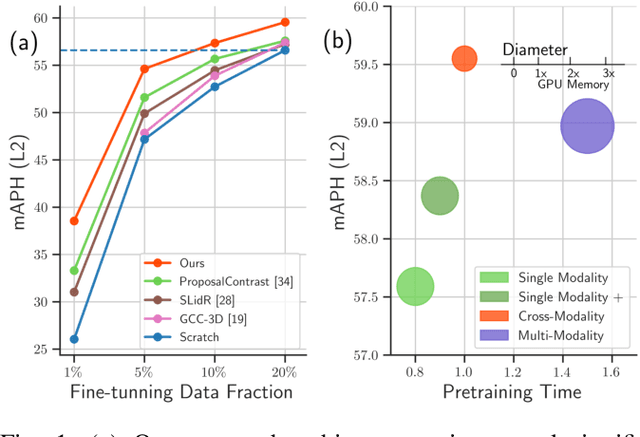
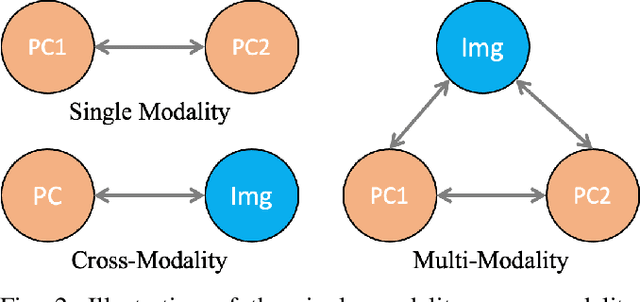
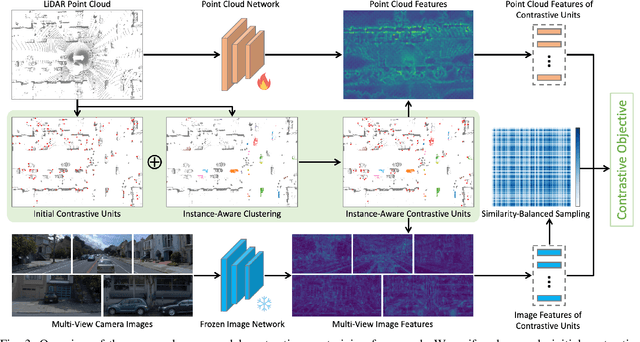
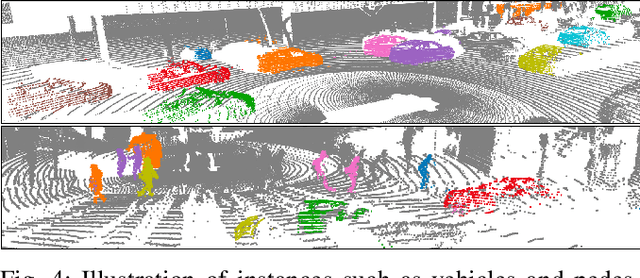
Abstract:3D perception in LiDAR point clouds is crucial for a self-driving vehicle to properly act in 3D environment. However, manually labeling point clouds is hard and costly. There has been a growing interest in self-supervised pre-training of 3D perception models. Following the success of contrastive learning in images, current methods mostly conduct contrastive pre-training on point clouds only. Yet an autonomous driving vehicle is typically supplied with multiple sensors including cameras and LiDAR. In this context, we systematically study single modality, cross-modality, and multi-modality for contrastive learning of point clouds, and show that cross-modality wins over other alternatives. In addition, considering the huge difference between the training sources in 2D images and 3D point clouds, it remains unclear how to design more effective contrastive units for LiDAR. We therefore propose the instance-aware and similarity-balanced contrastive units that are tailored for self-driving point clouds. Extensive experiments reveal that our approach achieves remarkable performance gains over various point cloud models across the downstream perception tasks of LiDAR based 3D object detection and 3D semantic segmentation on the four popular benchmarks including Waymo Open Dataset, nuScenes, SemanticKITTI and ONCE.
VGBench: Evaluating Large Language Models on Vector Graphics Understanding and Generation
Jul 15, 2024Abstract:In the realm of vision models, the primary mode of representation is using pixels to rasterize the visual world. Yet this is not always the best or unique way to represent visual content, especially for designers and artists who depict the world using geometry primitives such as polygons. Vector graphics (VG), on the other hand, offer a textual representation of visual content, which can be more concise and powerful for content like cartoons or sketches. Recent studies have shown promising results on processing vector graphics with capable Large Language Models (LLMs). However, such works focus solely on qualitative results, understanding, or a specific type of vector graphics. We propose VGBench, a comprehensive benchmark for LLMs on handling vector graphics through diverse aspects, including (a) both visual understanding and generation, (b) evaluation of various vector graphics formats, (c) diverse question types, (d) wide range of prompting techniques, (e) under multiple LLMs. Evaluating on our collected 4279 understanding and 5845 generation samples, we find that LLMs show strong capability on both aspects while exhibiting less desirable performance on low-level formats (SVG). Both data and evaluation pipeline will be open-sourced at https://vgbench.github.io.
LLaRA: Supercharging Robot Learning Data for Vision-Language Policy
Jun 28, 2024
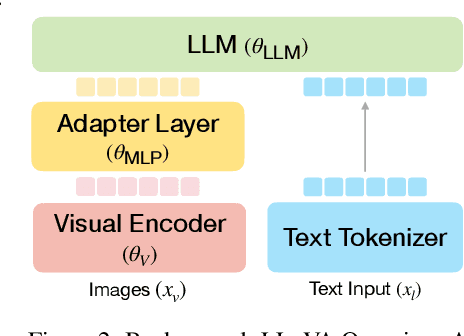


Abstract:Large Language Models (LLMs) equipped with extensive world knowledge and strong reasoning skills can tackle diverse tasks across domains, often by posing them as conversation-style instruction-response pairs. In this paper, we propose LLaRA: Large Language and Robotics Assistant, a framework which formulates robot action policy as conversations, and provides improved responses when trained with auxiliary data that complements policy learning. LLMs with visual inputs, i.e., Vision Language Models (VLMs), have the capacity to process state information as visual-textual prompts and generate optimal policy decisions in text. To train such action policy VLMs, we first introduce an automated pipeline to generate diverse high-quality robotics instruction data from existing behavior cloning data. A VLM finetuned with the resulting collection of datasets based on a conversation-style formulation tailored for robotics tasks, can generate meaningful robot action policy decisions. Our experiments across multiple simulated and real-world environments demonstrate the state-of-the-art performance of the proposed LLaRA framework. The code, datasets, and pretrained models are available at https://github.com/LostXine/LLaRA.
Yo'LLaVA: Your Personalized Language and Vision Assistant
Jun 13, 2024



Abstract:Large Multimodal Models (LMMs) have shown remarkable capabilities across a variety of tasks (e.g., image captioning, visual question answering). While broad, their knowledge remains generic (e.g., recognizing a dog), and they are unable to handle personalized subjects (e.g., recognizing a user's pet dog). Human reasoning, in contrast, typically operates within the context of specific subjects in our surroundings. For example, one might ask, "What should I buy for my dog's birthday?"; as opposed to a generic inquiry about "What should I buy for a dog's birthday?". Similarly, when looking at a friend's image, the interest lies in seeing their activities (e.g., "my friend is holding a cat"), rather than merely observing generic human actions (e.g., "a man is holding a cat"). In this paper, we introduce the novel task of personalizing LMMs, so that they can have conversations about a specific subject. We propose Yo'LLaVA, which learns to embed a personalized subject into a set of latent tokens given a handful of example images of the subject. Our qualitative and quantitative analyses reveal that Yo'LLaVA can learn the concept more efficiently using fewer tokens and more effectively encode the visual attributes compared to strong prompting baselines (e.g., LLaVA).
Matryoshka Multimodal Models
May 27, 2024



Abstract:Large Multimodal Models (LMMs) such as LLaVA have shown strong performance in visual-linguistic reasoning. These models first embed images into a fixed large number of visual tokens and then feed them into a Large Language Model (LLM). However, this design causes an excessive number of tokens for dense visual scenarios such as high-resolution images and videos, leading to great inefficiency. While token pruning/merging methods do exist, they produce a single length output for each image and do not afford flexibility in trading off information density v.s. efficiency. Inspired by the concept of Matryoshka Dolls, we propose M3: Matryoshka Multimodal Models, which learns to represent visual content as nested sets of visual tokens that capture information across multiple coarse-to-fine granularities. Our approach offers several unique benefits for LMMs: (1) One can explicitly control the visual granularity per test instance during inference, e.g. , adjusting the number of tokens used to represent an image based on the anticipated complexity or simplicity of the content; (2) M3 provides a framework for analyzing the granularity needed for existing datasets, where we find that COCO-style benchmarks only need around ~9 visual tokens to obtain accuracy similar to that of using all 576 tokens; (3) Our approach provides a foundation to explore the best trade-off between performance and visual token length at sample level, where our investigation reveals that a large gap exists between the oracle upper bound and current fixed-scale representations.
 Add to Chrome
Add to Chrome Add to Firefox
Add to Firefox Add to Edge
Add to Edge